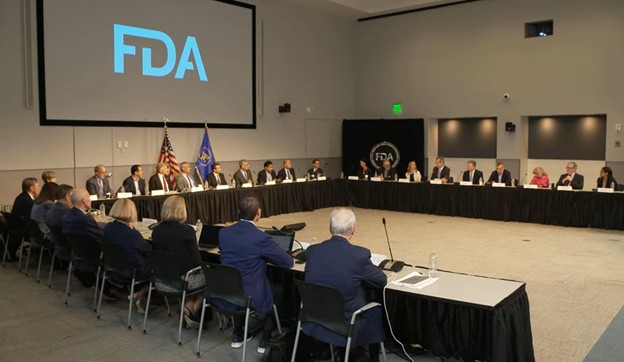FDA Cell & Gene Therapy Roundtable: Putting Every Patient Within Reach of Innovation
Terry Flotte, MD, and Paula Cannon, PhD - June 11, 2025
Roughly 15 million Americans - about half of them children - live with rare genetic disorders, yet more than 100 clinical stage gene therapy programs have been shelved since early 2023.

On June 5, the Food and Drug Administration (FDA) convened its first Cell & Gene Therapy Roundtable at the Agency’s White Oak campus, inviting researchers, regulators and patient advocates to discuss how breakthrough one-time treatments can reach every family that needs them. Moderated by FDA Commissioner Martin Makary, MD, MPH, and Vinayak Prasad, MD, MPH, Director of the FDA’s Center for Biologics Evaluation and Research (CBER), the session featured 23 highly esteemed voices including many long-standing ASGCT members and past President Donald Kohn, MD, Distinguished Professor of Microbiology, Immunology and Molecular Genetics at the University of California, Los Angeles. As the current and immediate past Presidents of the ASGCT Board of Directors, it was our honor to represent the Society during the discussion.

Each panelist had five minutes to make remarks, and we began ASGCT’s piece by zeroing in on commercial viability. Roughly 15 million Americans - about half of them children - live with rare genetic disorders, yet more than 100 clinical stage gene therapy programs have been shelved since early 2023, not for lack of scientific promise but because the market could not sustain them. While AAV products already keep spinal muscular atrophy infants alive and restore clotting in individuals with hemophilia, families facing equally severe conditions still have no options when sponsors deem potential therapies “commercially pre-viable.” To close that gap, we urged FDA to take a number of steps: broaden its Platform Technology Designation so a validated AAV or lentiviral backbone can roll into new indications with minimal added pre-clinical work; certify Advanced Manufacturing Technologies that cut per-dose costs; pair Accelerated Approval with adaptive “parachute” trials and robust real world follow-up; and preserve the Rare Pediatric Priority Review Voucher (PRV) program, which is a no-cost catalyst for private investment in ultra-rare pipelines.
For the second half of ASGCT’s remarks, we traced the field’s beginnings from bone-marrow transplantation to CRISPR editing. “Baby KJ,” an infant treated within seven months of diagnosis with a bespoke CRISPR base-editing therapy, is proof that plug-and-play delivery platforms can compress timelines even for n-of-1 conditions. Safety has always been paramount, but accumulated experience now permits responsible acceleration. We are now in a position to put our foot on the gas pedal.
Remarks from other participants warned that the United States is in danger of losing first-in-human studies to countries, such as China, where trials launch in roughly four years at a fraction of the cost, arguing that ultra-rare programs here will continue to move abroad unless early phase expectations become more flexible. Still other panelists focused on manufacturing economics, noting that current rules can require tens of millions of dollars in chemistry, manufacturing, and controls (CMC) work and multiple process-validation batches. Suggestions ranged from allowing single-lot qualifications to accepting GMP-like rather than full-GMP plasmids in exploratory studies. A third thread centered on post-approval realities: panelists urged broader use of Platform Designations, retention of the PRV program, and systematic real world evidence collection to confirm long-term benefit once products reach routine care. Panelists also asked that xenotransplantation follow graft standards already used in allogeneic organ transplants so life-saving trials can begin, while other panelists emphasized that any regulatory flexibility must still exclude unproven stem-cell clinics that would undermine credibility and trust of FDA.
Following remarks from external stakeholders, additional leaders from the Department of Health and Human Services (HHS) joined the conversation:
-
Jayanta Bhattacharya, MD, PhD, Director of the National Institutes of Health (NIH), hailed sickle cell therapies as a triumph of basic-science investment. He called for frameworks that let n-of-1 and ultra-rare trials proceed on mechanistic plausibility with robust follow-up.
-
Mehmet Oz, MD, Administrator of the Centers for Medicare & Medicaid Services (CMS), framed CGTs as root cause treatments that can transform CMS from paying for lifelong symptom management to underwriting definitive cures. He previewed payment pilots that spread a multi-million-dollar therapy’s cost across years and tie installments to durability, adding, “The reason this meeting is so important is because it will allow us to put on the table the real issues that hinder our distribution of life-saving, life-changing modalities in an effective way.”
-
HHS Secretary Robert F. Kennedy Jr. addressed both research and payment issues. He pledged to make the United States the global hub of biotechnology, noting that HHS has already secured full Medicaid coverage for sickle-cell gene therapy in one state and is negotiating with 38 others. Removing unnecessary hurdles and redirecting federal savings into further research, he said, will let cell and gene therapies give the gift of life while saving downstream costs. Directly addressing the panelists, Secretary Kennedy stated: “We're going to rely on you to come up with the solutions, and we're going to do everything in our power to sweep away the barriers from you getting those solutions to market and getting them funded, and do everything that we can to support you.”
Together, HHS Secretary Kennedy, NIH Director Dr. Bhattacharya, CMS Administrator Dr. Oz, FDA Commissioner Dr. Makary, and CBER Director Dr. Prasad agreed it is essential to pull every federal lever - funding, regulatory flexibility, and reimbursement policies - to move cell and gene therapies from bench to bedside swiftly, safely, and affordably. Their common refrain was clear: when government, academia, industry, and patient advocates work in concert, the United States can remain the global engine of biotech innovation while ensuring that transformative treatments reach every family who needs them.
ASGCT looks forward to remaining an active partner in those conversations and to help turn that shared commitment into real, timely access for all patients.
The full recording of the FDA Roundtable on Cell and Gene Therapy is available on YouTube.
Dr. Flotte is ASGCT's President and Provost of UMass Chan Medical School. Dr. Cannon is ASGCT's immediate Past President and Distinguished Professor of Microbiology & Immunology at the University of Southern California.
Related Articles